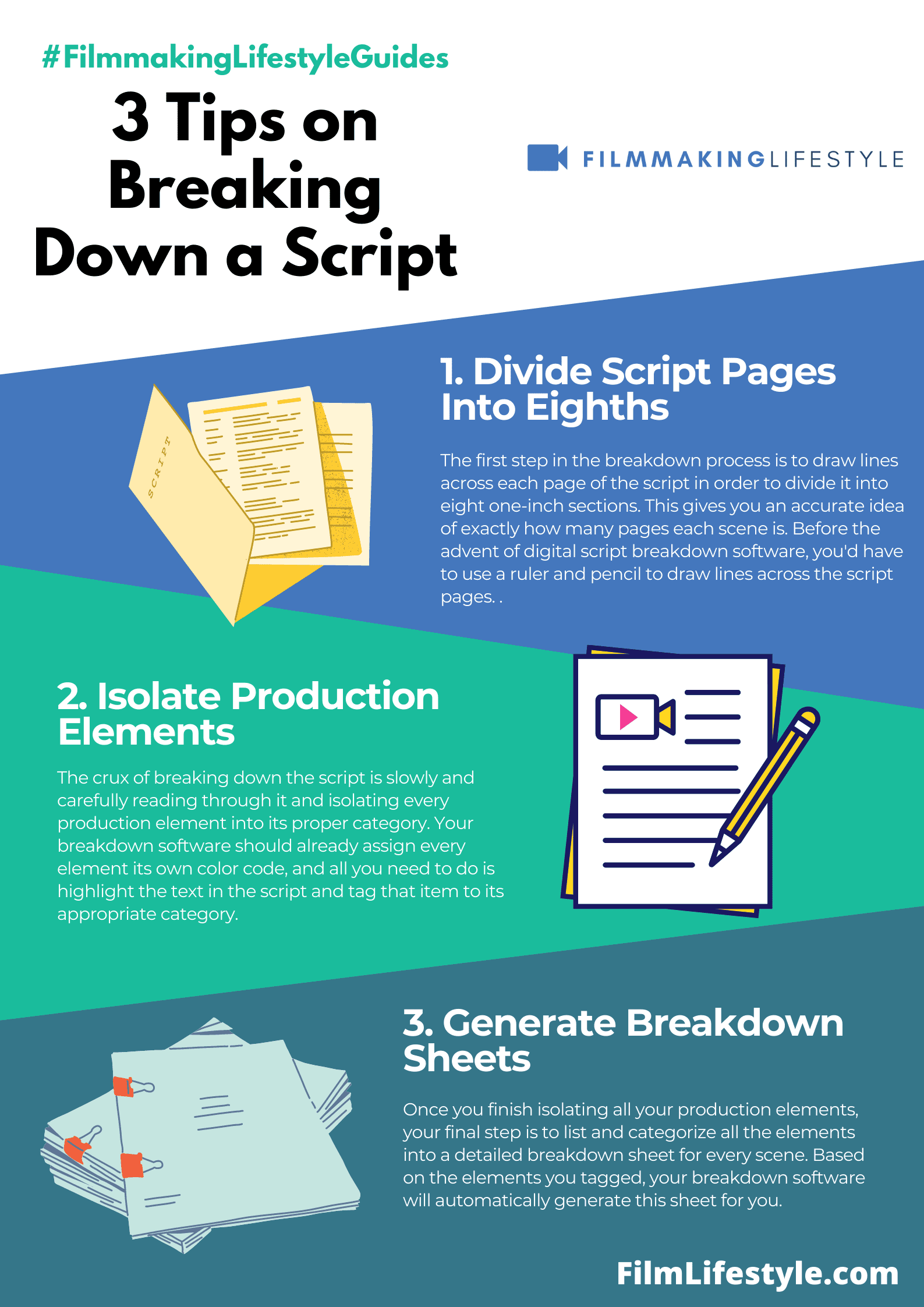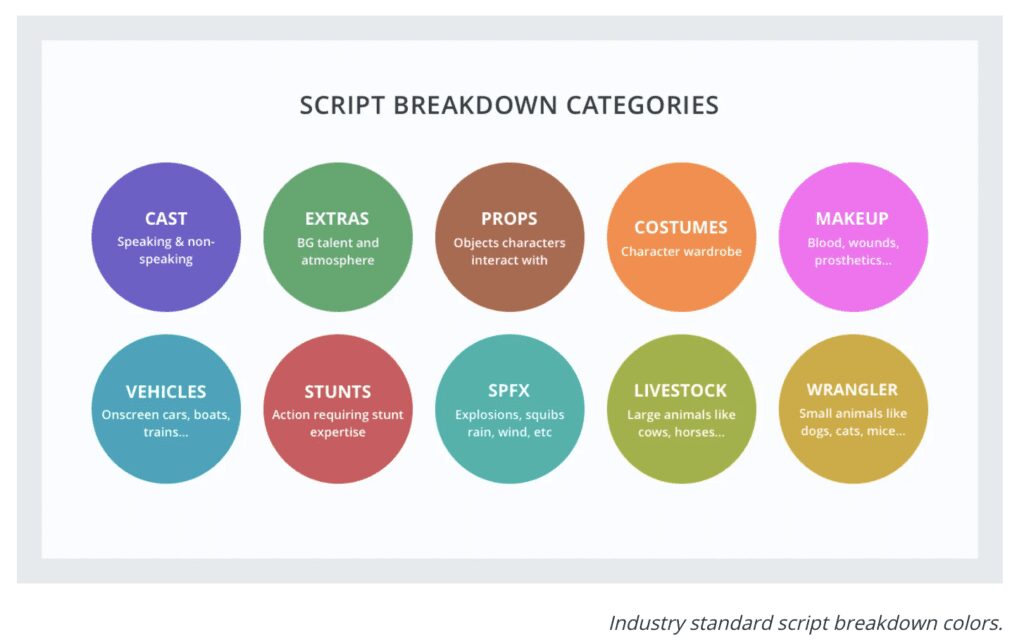Script breakdown is an initial estimate of the time required for all tasks necessary to complete a project.
The script breakdown includes estimations of how long each task will take to complete, and how much time it will take for various team members involved in the project.
Estimating script breakdown can be difficult as there are many variables that can affect the timeline such as unforeseen events or weather conditions.
BREAKING DOWN A SCRIPT
What Is Breaking Down a Script?
Script breakdown is the process of separating a script into each individual scene.
It’s important to understand that this does not just include dialogue, but also blocking and stage directions.
Breaking down a script may seem like an easy task at first glance, but it can be quite time-consuming once you get into the nitty-gritty details of what everything means.
If you are unfamiliar with any terminology in your script, then it is best to look up Google or Wikipedia for definitions or explanations before proceeding with a script breakdown.
Breaking down a script is a crucial step in transforming written pages into compelling visual stories.
It’s where we dissect the narrative and extract everything from character arcs to set requirements.
Understanding The Basics Of Script Analysis
Breaking down a script starts with script analysis.
This is our deep jump into the story’s mechanics.
Analysis allows us to peel back layers that reveal character motivations, thematic elements, and the narrative arc.
It’s about understanding the blueprint of the story we’re aiming to tell visually.
Before we bring characters to life on screen, we meticulously explore their journeys.
Each scene in the script is a puzzle piece.
It fits into the broader story.
We’re not just looking for what characters say.
We’re seeking out why they say it and how their words drive the story forward.
We consider multiple factors during script analysis, including:
- Character development – Every character must feel real and have depth.
- Scene objectives – We determine the purpose of each scene. What must it accomplish?
- Story structure – Identifying the inciting incident, rising action, climax, and resolution helps us to craft the visual flow.
Armed with this information, we identify all the key elements needed for production:
- Locations required for each scene,
- Props and costume details that align with character arcs,
- Special effects or stunts that may be necessary.
By delving into the subtext, we understand the undertones that are not explicitly stated.
Dialogue analysis is crucial.
It often holds the key to both obvious and subtle character traits.
It’s also where humor, tension, and drama reside.
Emotions are the currency of filmmaking.
Script analysis is about unlocking the emotional heartbeat of a screenplay.
It ensures that every creative choice we make aligns with the story we’re telling.
We astutely map out the dramatic beats to maintain pacing and tension.
Recognizing shifts in tone ensures the final film communicates the intended experience.
Every scene, every line, and every action contribute to a holistic understanding of the script.
The continuous process of script analysis evolves as we transition from paper to the screen.
It’s an invaluable tool that lays the groundwork for filming.
It also informs our decision-making at every production stage.
Analyzing The Characters And Their Arcs
In tackling the dissection of characters within a script, we jump into their intrinsic motivations and the journeys they undertake.
It’s crucial to understand where each character starts emotionally and psychologically, and where they end up by the story’s climax.
We look for the transformation – subtle or drastic – that the characters experience through the narrative.
This change, often known as the character arc, is the heart of character development and drives engagement with the audience.
Character analysis requires more than a surface-level read.
We pay attention to their dialogue, actions, and choices that reveal deeper traits and potential foibles.
Some of the pivotal elements to scrutinize include:
- Goals and aspirations – what the characters desire to achieve,
- Obstacles and stakes – what stands in their way and what they stand to lose,
- Relationships and conflicts – how they interact with others and the tensions that arise.
Characters are the vessels through which the story is told.
Their arcs are the roadmap for the emotional investment an audience will make.
To ensure the characters resonate onscreen, we make sure their stories are compelling, believable, and ripe with narrative necessity.
Recognizing secondary characters and their significance to the primary narrative can be just as important.
They often provide support or opposition that catalyzes the protagonist’s growth or decline.
We analyze each character in alignment with the larger narrative arc.
It ensures the broader narrative mechanics are in sync with individual character journeys.
Throughout this meticulous process, we ensure that every decision About the characters, their depiction, and development serves the story’s primary objective.
It’s a step that guarantees the storytelling remains cohesive from the first act to the final moment before the credits roll.
Breaking Down The Plot And Structure
Analyzing the plot and structure is critical in breaking down a script.
It allows us to see the blueprint of the story’s progression and the framework holding everything together.
Plot is the sequence of events that construct the narrative.
It shapes the journey our characters embark upon.
Structure, on the other hand, dictates how this sequence is presented to the audience.
Think of classic structures like the three-act paradigm – they serve as the backbone for most of our storytelling in film.
Some scripts may follow non-linear storytelling techniques.
This approach can make our plot analysis more complex.
Films like Memento or Pulp Fiction challenge traditional narrative structures.
They require a meticulous dissection to understand how their plots unfold out of chronological order.
Deep dives into plotting techniques reveal –
- The inciting incident,
- Plot points and twists,
- Climactic moments and their placement.
While analyzing structure, we pay close attention to –
- The sequence of acts,
- Pacing and tempo,
- Juxtaposition and parallel storylines.
Each element interacts to create the rhythm of our film, just as a maestro directs an orchestra.
Ensuring these elements align correctly keeps our audience invested in the film’s unfolding story.
The symbiotic relationship between plot and structure can’t be overstated.
One cannot function without the other in the pursuit of a cohesive narrative.
By breaking down these elements, we strengthen our understanding of the script.
We can then foresee pacing issues or plot inconsistencies before they reach the screen.
Examining The Dialogue And Subtext
Delving into the dialogue of a script is like peering through a window into the characters’ souls.
We grasp the explicit aspects of their personas while probing for the implicit messages conveyed between the lines.
Dialogue can tell us what characters want, but subtext reveals their true intentions.
To truly appreciate the craftsmanship of dialogue, we need to consider not only what is said but how and why it is said.
The rhythm, tone, and choice of words a character uses all contribute to their unique voice.
Sharp dialogue cuts straight to the point, while more reflective characters might use stories or metaphors.
For example, Aaron Sorkin’s rapid-fire exchanges in The Social Network encapsulate the intensity and intelligence of its subjects.
Subtext, on the other hand, operates on an understated level.
It’s the unspoken tension in a scene or the underlying emotions that characters are not willing to verbalize.
This layer of meaning adds depth to the narrative, often revealing:
- Hidden agendas,
- Emotional conflicts,
- Social or cultural contexts,
- Power dynamics.
Recognizing and interpreting subtext requires a keen sense of reading between the lines.
It’s not just about the words themselves, but also the silences, the pauses, and the unsaid.
It’s about understanding the context of a scene or the entire narrative arc.
Remember, every bit of dialogue in a screenplay has been meticulously chosen.
We must analyze why a character chooses to speak or remain silent at any given moment.
Mastery of dialogue and subtext analysis is essential for us to decipher the full picture of the story being told.
Identifying Visual And Technical Elements
After dissecting dialogue and subtext, it’s critical to focus on the visual and technical components of the script.
These elements are fundamental in translating a narrative from page to screen.
It’s the visuals that often leave a lasting impression on the audience.
Our role includes the meticulous breakdown of how each scene is constructed visually.
This encompasses the setting, colors, costume design, and lighting.
Technical elements play a crucial part in storytelling as well.
We concentrate on the script’s directives for camera movements, angles, and editing transitions.
These cues help us envision the final cut even before cameras start rolling.
Breaking down a script also involves attention to sound design.
Here’s what we keep an eye out for:
- The use of diegetic and non-diegetic sound – Music cues and their intended effect – Sound effects that heighten the narrative’s impact.
Consider how these audio choices will shape the viewer’s experience.
Will they create tension, provide relief, or enhance the film’s atmosphere?
Set design and location choices are key visual factors in the script that can’t be overlooked.
They set the stage for our characters’ journeys.
Choices here will dictate the authenticity and believability of the world we’re creating.
Attention to props is equally important.
They are not mere objects but carry symbolic weight and can be pivotal in driving the plot forward or developing a character’s arc.
By highlighting these visual and technical details, we’re crafting a blueprint for the filmmaking process.
Every aspect of script breakdown helps pave the way to a cohesive and compelling film.
Breaking Down A Script – Wrap Up
We’ve taken a deep jump into the intricacies of script analysis, uncovering the layers that make characters and narratives resonate with audiences.
It’s clear that the words spoken by characters and the unspoken tension of subtext are as crucial as the visual storytelling elements that bring a script to life.
Through our exploration, we’ve seen how every choice, from dialogue to set design, weaves together to form a tapestry of meaning.
As we move forward, let’s carry these insights into our next creative Try, ensuring that our understanding of these components informs the stories we help to tell on screen.
Frequently Asked Questions
What Is The Main Purpose Of Analyzing Dialogue In Script Analysis?
Analyzing dialogue is crucial for understanding the characters’ explicit statements and the nuanced, implicit aspects of their communication.
Recognizing their unique voices, rhythm, tone, and word choice helps to deepen character development and the narrative.
How Does Subtext Contribute To A Narrative?
Subtext enhances the depth of a narrative by revealing characters’ hidden agendas, emotional conflicts, and underlying social or cultural contexts.
It is a key factor in understanding the broader story and the dynamics between characters beyond what is said explicitly.
Why Is It Important To Read Between The Lines In Script Analysis?
Reading between the lines is essential to grasp the subtext and context that are not directly stated in the script.
This approach helps in identifying the deeper meanings, intentions, and relationships that drive the narrative forward.
In Script Analysis, Why Are Visual And Technical Components Examined?
Visual and technical components such as setting, color schemes, costumes, lighting, camera work, and sound are examined because they are integral to turning the written script into a visual experience.
They contribute to the storytelling by creating the film’s aesthetic and affecting the audience’s perception.
How Does Analyzing All These Elements Affect The Final Film?
By analyzing dialogue, subtext, and visual/technical elements, filmmakers and analysts can decipher the full story and ensure that all aspects of the script align to create a cohesive and evocative cinematic experience.
This holistic view is key to crafting a compelling film.




